
A tinge of the old droving days filters through, even though Clancy is no longer around singing while the stock is slow stringing.
We don’t know where he is but we do know he has been replaced by road trains. Consequently stock routes have been upgraded and are peaceful to savour. Some sections can be rough but most are surprisingly smooth.
In a 1500km wander we avoided the busy bitumen except for about 200km, never needed to use Isabel’s 4WD, soaked up the solitude and debated whether the cat that eyeballed us insolently was a panther.
Panthers are elusive in dictionaries. A variety of definitions exist revolving mainly around large black cats – leopards, jaguars or any other feline species. We decided the inky, kelpie-sized cat that eyeballed us qualified.
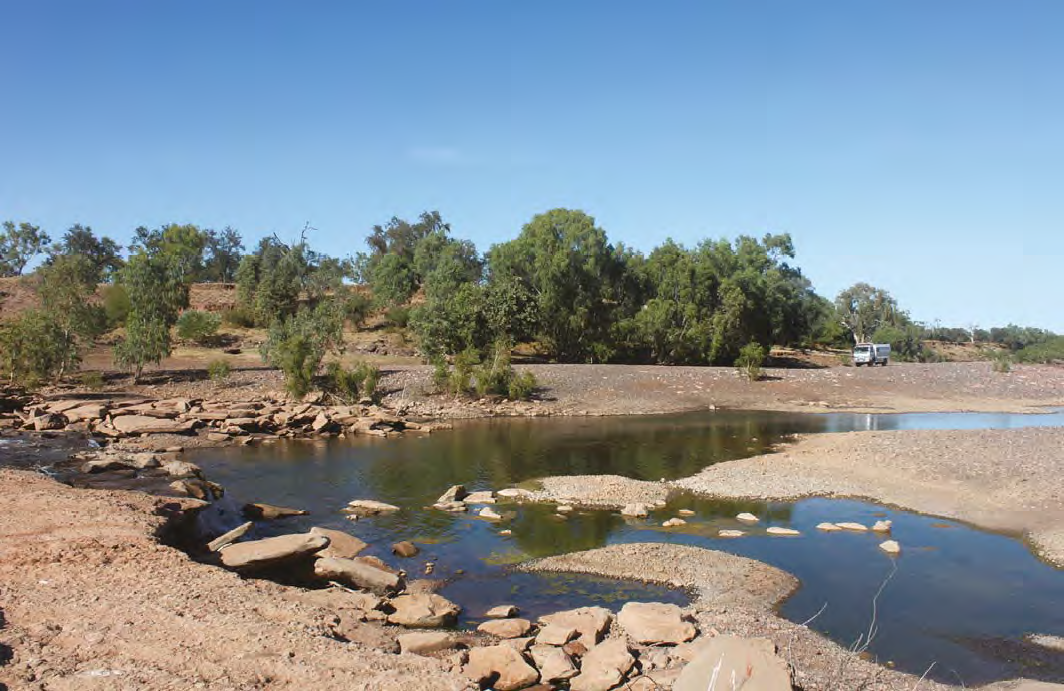
You have to wander some distance before Isabel seems small
We had meandered 270km down the eastern side of Lake Argyle on the Duncan, a well maintained dirt road with plenty of scenic camp spots. Overnighting on a grassy site overlooking the Negri River, Tony lit a campfire and swept a torch along the river, picking out red crocodile eyes in the dark.
This was freshwater croc territory, above Lake Argyle, but we were curious to spot one set of eyes 20cm or more apart. We never went close enough to determine if it was a giant freshie, a stray saltie or two small freshies teasing by staring at us with their heads snugly together, inside eyes closed.
Traffic was almost non-existent after we turned east on to the unsealed Buntine Highway. That suited us well for an easy 400km and peaceful campfi re on a ridge.
Pulling up for morning coffee on the side of the Buntine, our eyes widened as our panther – the largest feral cat I had ever seen – padded arrogantly across the road in front of us. Solid black and swaying its impressive tail languidly, it barely cast a disdainful glance in Isabel’s direction.
“That’s why you hear stories about panthers being spotted in the bush,” said Tony before we launched into an animated discussion about the growing feral cat problem in Australia – growing both in terms of numbers and the size of the animals.
For some reason the conservation movement doesn’t see the destruction of feral animals or exotic weeds as a priority yet both pose a far bigger threat to Australia’s flora and fauna than people. Perhaps it’s because shooting is the only effective way to destroy feral pigs and cats: conservationists don’t like anything to do with guns.
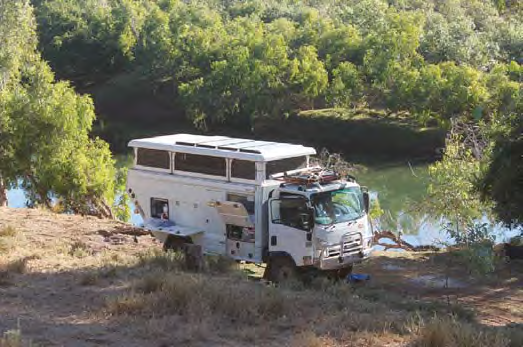
Negri River campsite
We saw our panther for only a few seconds but contemplated for hours on the how many small, timid native animals it would slaughter in a night. Bilbies, quolls, bandicoots, birds and frogs are defenceless in the night vision of a stalking cat; lizards and snakes are easy prey in the day.
An hour later the day took a cheerier turn at Top Springs where we met legendary manager Pauline Heseldine, crackling with life and fun. Pauline, somewhere in her 60s, is one of those sparkling characters you find in the bush where fresh food is scarce and cheap fuel is non-existent.
In 2002, she left Adelaide to visit a friend in Katherine. She took a three-week post as a cook at Montejinni Station, 15km south-west of Top Springs.
“It just sort of kept extending,” she said.
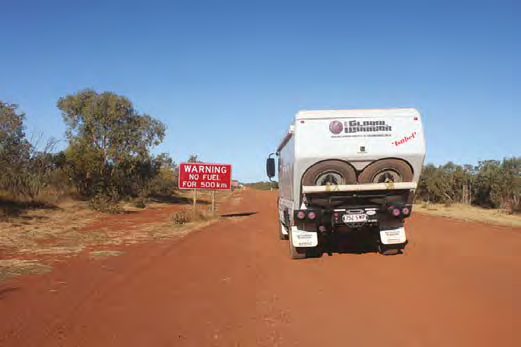
No fuel - no worries
Six months later she sold her house in Adelaide. Eight years ago she became manager of the complex at the junction of the Buntine and Buchanan highways owned by the Jones family, featured in the TV series Keeping up with the Joneses.
Pauline is a pal to station crews, itinerant workers, anyone in need and the indigenous people from Kalkaringa community, 170km back down the track. In 1966, Kalkaringa was the scene of a seven-year strike by 200 Aboriginal station hands and house workers who walked off the adjacent Wave Hill Station, first seeking improved pay and conditions but escalating into a demand for their land back from the Vestey empire.
From Top Springs to the Stuart Highway, the 180km stretch is the best part of the Buchanan Highway (unsturdy campers fl y to bits on it north west of Top Springs). We camped, scooted down the Stuart bitumen for 130km and turned off on to the 229km Barkley Stock Route to camp alone in the bush again.
We had an 85km section of the sealed Tablelands Highway to negotiate. A rest area showed on the map. We headed for it and stopped early to do a few chores. RVs, camper-trailers and caravans started surrounding us. Suddenly I felt crowded.
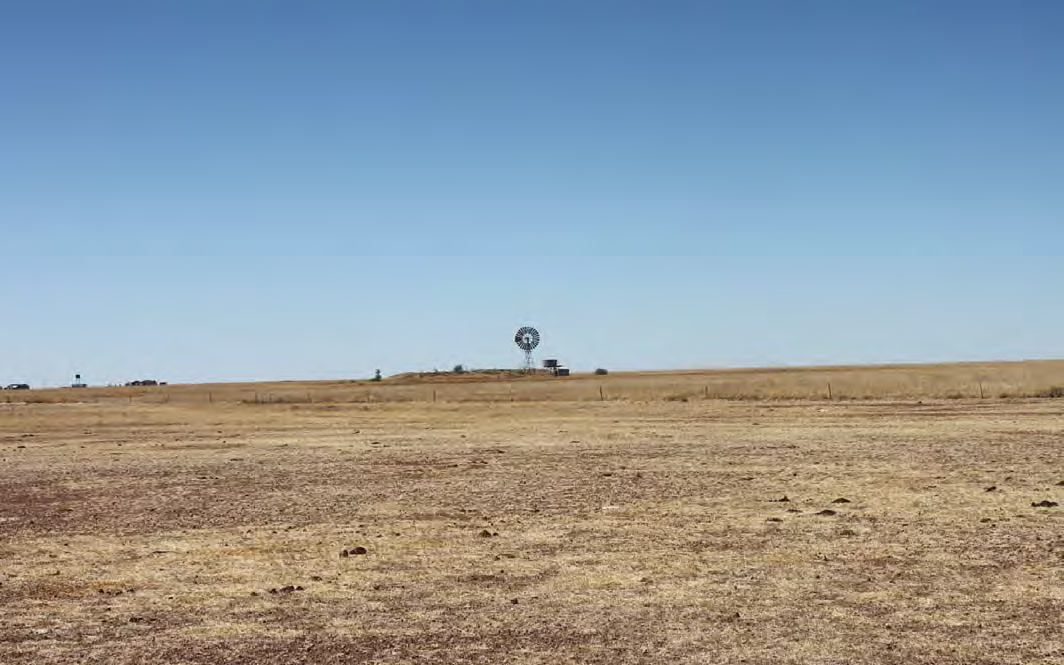
The languid windmill on a hill near the lonely abandoned Ranken Store
We shot off in the late afternoon, turned on to the Ranken Road just above Brunette Downs and sighed happily. The sign said no fuel for 500km. That meant peace and opportunity to kid ourselves we were a little like Clancy. We shot up a dry, rocky creek bed and camped there.
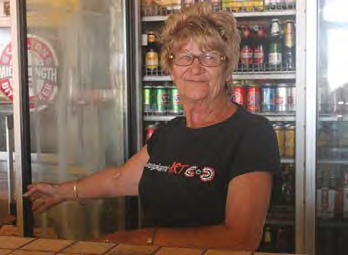
Pauline Heseldine
Ranken Road was a delight. An information bay near the fauna-extraordinaire Connell’s Lagoon had a visitors’ book where station hands and travellers left messages: “Beats the black top,” said Dave and Vivien. “Great to see the natural landscapes preserved. Love the back roads!!” declared Reg and Robyn, heading back to Dubbo after the Kimberley. A bunch from Anthony Lagoon stock camp, including a grader driver, governess and Bertamous Maximus wrote they were “travelling back from Camooweal rodeo, hung over and ready for bed”.

Camp by water point
We camped at a waterpoint camp where flowers were blooming, including camel cabbage planted by Afghan cameleers. Clancy would have loved it (I know, he was in Queensland droving, not the NT). A windmill waved tiredly on a barren hill above the old Ranken Store, once a thriving business on the old route.
After 220km on the Ranken we turned onto the Barkley Highway and popped into the free roadside camp at Avon Downs. It was packed with campers – and it was time for a chat again.
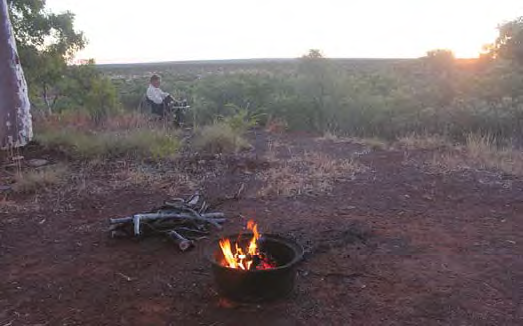
Enjoying a sundowner
Category: Unknown
Written: Fri 01 May 2015
Printed: May, 2015
Published By:
NANCY BATES Q83355